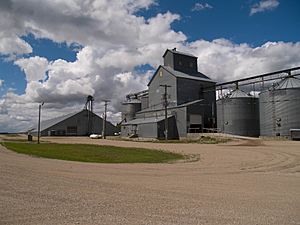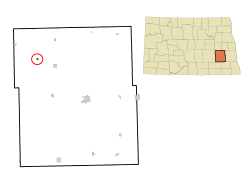Leal, North Dakota facts for kids
Quick facts for kids
Leal
|
|
|---|---|

Grain elevators in Leal
|
|

Location of Leal, North Dakota
|
|
| Country | United States |
| State | North Dakota |
| County | Barnes |
| Founded | 1892 |
| Incorporated (village) | 1917 |
| Incorporated (city) | 1967 |
| Named for | Scottish for "faithful" |
| Government | |
| • Type | Mayor-Council |
| Area | |
| • Total | 0.13 sq mi (0.33 km2) |
| • Land | 0.13 sq mi (0.33 km2) |
| • Water | 0.00 sq mi (0.00 km2) |
| Elevation | 1,467 ft (447 m) |
| Population
(2020)
|
|
| • Total | 27 |
| • Estimate
(2022)
|
24 |
| • Density | 209.30/sq mi (80.87/km2) |
| Time zone | UTC-6 (Central (CST)) |
| • Summer (DST) | UTC-5 (CDT) |
| ZIP code |
58479
|
| Area code(s) | 701 |
| FIPS code | 38-45460 |
| GNIS feature ID | 1029852 |
Leal is a city in Barnes County in the state of North Dakota. The population was 27 at the 2020 census. Leal was founded in 1892. The name comes from the Scots word for "faithful," which in the phrase laund o the leal means Heaven.
Contents
History
Scottish-English emigrants from Ontario, Canada, originally settled in this area in 1883. The townsite of Leal was platted in 1892, and a post office established December 28, 1892. Officials with the Soo Line Railroad established a station here in 1902.
Leal incorporated as a village in 1917 from part of Edna Township. It became a city in 1967, after the North Dakota Legislature eliminated incorporation titles for villages and towns. As a result, all incorporated municipalities in North Dakota automatically adopted a city form of government.
Geography
Leal is located in Edna Township in the northeastern part of Barnes County. It is 73 miles (117 km) west of Fargo, and the nearest city is Rogers.
According to the United States Census Bureau, the city has a total area of 0.14 square miles (0.36 km2), all land.
Climate
Due to its location in the Great Plains and distance from both mountains and oceans, the city has an extreme continental climate, USDA Plant Hardiness Zone 4. The lowest temperature ever recorded was −37 °F (−38 °C) on December 23, 1983, and the highest temperature ever recorded was 106 °F (41 °C) on July 30, 2006.
Demographics
| Historical population | |||
|---|---|---|---|
| Census | Pop. | %± | |
| 1920 | 88 | — | |
| 1930 | 105 | 19.3% | |
| 1940 | 102 | −2.9% | |
| 1950 | 72 | −29.4% | |
| 1960 | 70 | −2.8% | |
| 1970 | 41 | −41.4% | |
| 1980 | 45 | 9.8% | |
| 1990 | 35 | −22.2% | |
| 2000 | 36 | 2.9% | |
| 2010 | 20 | −44.4% | |
| 2020 | 27 | 35.0% | |
| 2022 (est.) | 24 | 20.0% | |
| U.S. Decennial Census 2020 Census |
|||
2010 census
As of the census of 2010, there were 20 people, 10 households, and 6 families residing in the city. The population density was 142.9 inhabitants per square mile (55.2/km2). There were 11 housing units at an average density of 78.6 per square mile (30.3/km2). The racial makeup of the city was 95.0% White and 5.0% from two or more races.
There were 10 households, of which 10.0% had children under the age of 18 living with them, 40.0% were married couples living together, 20.0% had a female householder with no husband present, and 40.0% were non-families. 40.0% of all households were made up of individuals, and 10% had someone living alone who was 65 years of age or older. The average household size was 2.00 and the average family size was 2.50.
The median age in the city was 53 years. 15% of residents were under the age of 18; 10% were between the ages of 18 and 24; 15% were from 25 to 44; 45% were from 45 to 64; and 15% were 65 years of age or older. The gender makeup of the city was 35.0% male and 65.0% female.
See also
 In Spanish: Leal (Dakota del Norte) para niños
In Spanish: Leal (Dakota del Norte) para niños


